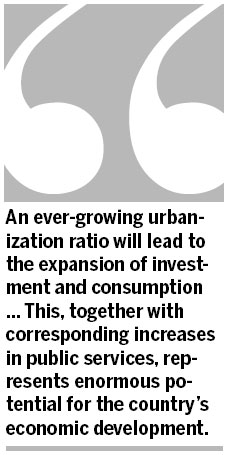Tapping growth potential
By Zheng Xinli (China Daily) Updated: 2012-02-01 08:01

Deepening reform and expanding opening-up will inject new vitality into economic development over the next two decades
China's economic growth declined to 9.2 percent in 2011, down from 10.4 percent a year earlier, as the result of the tightened monetary and banking policies adopted to rein in inflation. This moderate decline is within government expectations and still overshadows economic performance in the rest of the world.
But there are still some in China and beyond who have expressed concerns over the country's economic prospects, believing China's fast-growing economy has already run out of steam after more than 30 years of marvelous development and that the pace will continue to decelerate. Some have even predicted the country's economy will suffer a hard landing. Such concerns and conclusions, however, contravene China's basic national conditions and the huge economic potential that remains to be tapped.
There is no doubt the country's economy can maintain a few more decades of fast growth if continuous reforms are adopted to release this new vitality.
China's enormous demand potential is yet to be realized and stimulating this will help keep the economy on a fast growth track. By the end of 2011, the country's urbanization ratio had reached 50 percent, a symbolic figure in the country's history, but still far behind that of developed countries. The ratio is expected to rise to 70 percent in the next two decades if it is raised by one percentage point ever year. An ever-growing urbanization ratio will lead to the expansion of investment and consumption. Statistics show that one higher percentage point in China's urbanization ratio will mean an investment of about 1 trillion yuan ($158.26 billion) in infrastructure construction every year. This, together with corresponding increases in public services, represents enormous potential for the country's economic development.
China's per capita GDP was $4,200 in 2010 and is expected to reach $12,000 in 2026, a level that serves as the demarcation line between middle-income and high-income countries under the World Bank criteria. That means China will walk out of the "middle income trap" after another 15 years of fast development and begin moving toward the rank of high-income countries. However, China's fast development will not inevitably stop even at that time, because the experiences of neighboring Japan and South Korea show that the fast-growing economic momentum of a country will come to a halt only after its per capita GDP reaches $17,000.
With the transformation of its economic development pattern, the country's efforts to expand domestic demand and adjust its income distribution structure will be further pushed forward and these will act as the driving force for national economic development.
The Chinese government has vowed to raise the resident consumption ratio by 10 percentage points during the 12th Five-Year Plan (2011-2015) period and accelerate adjusting its income distribution structure. These, if realized, will create an additional 4-5 trillion yuan every year in the country's consumer goods retail value. Compared with its 48.6-percent investment to GDP ratio in 2010, China's ratio of resident consumption to GDP was only 33.2 percent. The ratio was 70 percent in the United States the same year. The releasing of such enormous consumption potential will bolster a fast, steady and sustainable economic development in the coming 20 years.
China's enormous capital potential will be another driving force behind its fast development in the decades ahead. By the end of October 2011, the country's yuan assets had reached 80 trillion. Such colossal capital power, if better utilized through reforms of its monetary and financial systems, will support the country's fast economic development for a long period.
And if the country's $3 trillion-strong foreign reserves are shifted from the current heavy investment in the US national debt to overseas energy and resource purchases, it will break its long-standing resource bottleneck. China should use the lion's share of its foreign reserves to purchase more resources and energy in the international market and to obtain more overseas acquisitions as a way to boost its self-innovation capability and facilitate its long-term development.
China's ongoing agricultural modernization and mechanization and its accelerated efforts to transform the sector from a long-established extensive to an intensive model will also emancipate a large number of rural laborers, which will offer a solid labor supply for urban development. The so-called Lewis turning point that some demographers and sociologists believe China has reached will not come for decades.
Despite its huge development potential, China still needs some reforms to ensure it is released. But if the country continues adhering to the policy of deepening reform and expanding opening-up, then its fast economic development is guaranteed for the next few decades.
The author is standing vice-chairman of China Center for International Economic Exchanges.
(China Daily 02/01/2012 page8)











